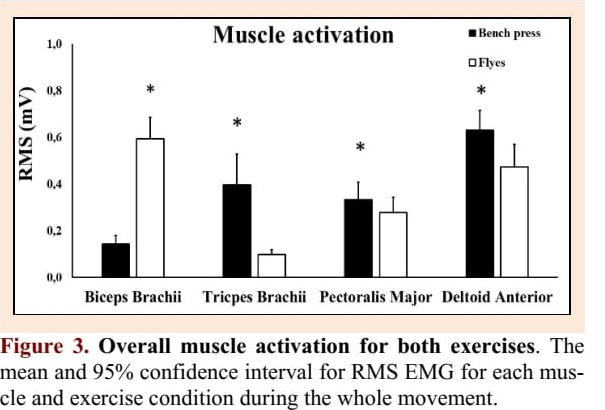Suppose you do all kinds of chest presses (flat and incline, with barbell and/or dumbbells), do you also have to do flyes for a complete development of your chest?
RESEARCH
Researchers decided to compare the two basic chest exercises: bench presses versus dumbbell flyes. It was an EMG (electromyography) examination, which means that the electrical activity of the muscles is measured.
RELIABILITY
The results of EMG studies are often unreliable, because the relative intensity (effort) of the different exercises is not equalized, or because the training is not short enough for muscle failure. These matters were in order during this investigation though, concludes coach Menno Henselmans .
OUTCOME
The bench press came out as a convincing winner: the activity in triceps, chest and the anterior delts (front shoulders) was much greater than with the flys. Only the biceps are stimulated more by flyes.
 The muscle activation according to EMG measurement, over the full range of motion of the exercises. Source: Solstad et al, 2020 .
The muscle activation according to EMG measurement, over the full range of motion of the exercises. Source: Solstad et al, 2020 .A CLOSER INTERPRETATION
Does that make the chest fly unnecessary? No. Because, according to Henselmans, you also have to look for differences within the range of motion of the exercise, the range of motion (ROM).
DIFFERENCES WITHIN THE ROM
The big difference in muscle activity is mainly in the top third of the ROM: with the press the chest is still active there, with the fly hardly any more (as we saw before). In this sense, the press trains your chest over a greater ROM, which is generally the best for muscle growth.
Flyes, however, provide a better stretch of the chest at the bottom of the movement than the barbell press, as it turns out. Which makes sense, since the barbell can’t lower beyond the chest. Which incidentally can be an argument for doing the dumbbell chest press, where you can lower a bit more and thus achieve a better stretch.
In addition, the chest fly appeals to a different function of the chest than the press, namely adduction, i.e. moving your chest and shoulders towards the center of your body. This puts more emphasis on the outer part of the pectoralis major muscle (the pectoralis major).
The chest fly does have a number of favorable properties that distinguish the exercise from the bench press.
VARIATION IN EXERCISES
More generally, you can say that you have to train most muscle groups with different movements (ROMs) to develop them optimally. Coach Steve Hall (of platform Revive Stronger) concludes following from a debate between coaches Mike Israetel and Nick Tumminello:
There are no perfect exercises that are going to hit the muscle at its full range completely. Therefore we want to have some variation within our training program if we want full muscular hypertrophy.
The word ‘within’ is important. Variation means that you do a number of different exercises per muscle group in one training program, but consistently, so that you can apply progressive overload in the long term. So don’t do other exercises every once in a while.
We recently came to the conclusion that, also for other reasons, you need two to four different exercises per muscle group.
So the barbell bench press alone is not enough to fully develop your chest, nor your triceps and anterior delts. Menno Henselmans about this:
Bench presses are a fine compound exercise, but they’re likely not perfect for either the pecs, delts or the triceps. You should add more targeted exercises to optimally stimulate each muscle.
ADVICE
Based on the foregoing, plus the current insights regarding training volume and intensity, the following advice.
1. To train your chest optimally, you need roughly 10 (beginners) to 20 (advanced) sets per week. This is based on a modal effort, so short on muscle failure, but usually slightly away (1-3 RIR).
2. Divide those sets into at least two movements: a press (barbell or dumbbell press) and a fly. As you need more sets to grow, you can add an incline press to give the top of your chest some specific attention.
3. Looking purely at the stimulation of the chest, the dumbbell chest press is probably more effective than the barbell version, which is more of an overall compound exercise for your upper body, especially for chest, shoulders and triceps.
4. At an even later stage in your career, you can do a third movement for your chest if you wish, namely a the dumbbell pullover.
5. Do a maximum of 5-10 sets per workout for your chest. So don’t make it a ‘chest day’ or marathon session.